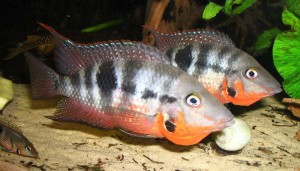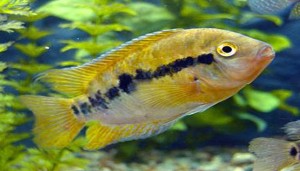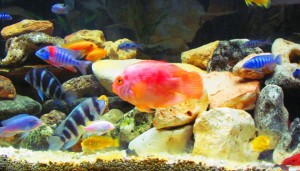The Salvini Cichlid – A Colorful Wizard
The Salvini cichlid (en: Cichlasoma salvini) is a colorful South America cichlid, known also as yellow belly cichlid or tricolor cichlid, due to its impressive colors. While juveniles have a less shiny grey color, adults are bright yellow with two lines of black and blue dots running through their body. They possess long turquoise fins and have red bellies, a coloration that gets more intense during the breeding period and is more pronounced in males. Moreover, females have a small black patch in the center of their dorsal fin and the cover of their gills and are generally smaller, making it fairly easy to distinguish between the sexes. Salvini cichlids reach a maximum size of 8 inches (20 cm) but they normally remain smaller in aquariums.
The species can live for about 13 years and can be encountered in rivers and lagoons of the northern South America, such as South Mexico, Guatemala and Belize. It usually prefers rivers with moderate to strong flow and commonly inhabits spots with dense tropical vegetation which provides shelter and plenty of hideouts, as the species intense coloration would make it difficult to escape from potential predators. As a result Salvini cichlids would live happily in 50 gallon tanks (150 L), filled with fine gravel or sand and decorated with a variety of rockwork, pots, roots and plants in order to provide hiding spots. Water should be kept at a temperature between 22-27 °C (72-81 °F), and water quality should include a pH between 7-8 and dh around 5-20.
Despite being a very shy fish, it is moderately aggressive and can be quite territorial especially during the breeding season. It can be kept in a community aquarium, as long as its neighbours are moderately aggressive species too. Examples of potential candidates are the red devil and the oscar. On the other hand, small species will quickly become a snack for the Salvini cichlid, as it is an omnivore, eating all possible kinds of food. It can be fed pellets and flakes, accompanied with a variety of frozen food such as earthworms or shrimp. Vegetables such as zucchini and peas would consist a good addition, since a wide variety of food sources will enhance the stunning coloration of this species.
Salvini cichlids are not mouth brooders, as is the case for the majority of cichlid species. The females usually spawn on a territory that is chosen by the male which is usually on a rocky spot or in a small cave, as the Salvini cichlid is sometimes a cave spawner in its natural habitat. After fertilization both individuals guard the eggs and males can get quite aggressive with any fish that will attempt to approach. Fries hatch in about five days and remain at the spawning site until they become free swimming, which happens a few days later. It is quite often for the female to dig pits in the sand and gravel in order to provide shelter to the young fries. Another common and entertaining behavior, known as “fanning”, includes a variety of movements with the tail in order to create mild currents above the eggs and provide them with oxygen.
The Salvini cichlids are among the most famous cichlids of South America, due to their stunning colouration and aggressive temperament, despite their small size. Although not recommended for the beginner, with proper care it can be a beautiful addition to a cichlid aquarium.










